Lithuania in Japan: people and books
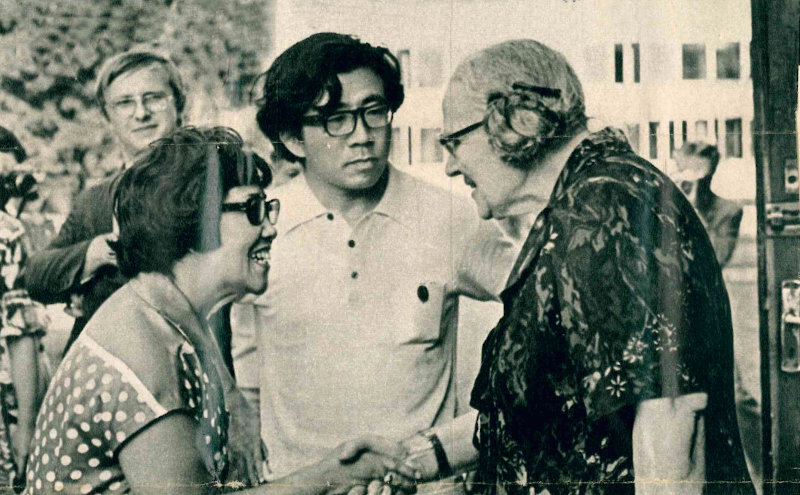
Probably everyone in Lithuania knows about Japan, but Lithuania, which re-appeared on the world map thirty years ago, has been unknown to the Japanese for a long time. Fortunately, such stories as Ch. Sugihara‘s "Visas for Life" linked the two countries and increased the Japanese interest in Lithuania. In recent decades, Lithuania get more and more opportunities to present its culture through Fluxus works, theater and music exchanges, various exhibitions, and events.
(Ichiro Kato (center) meeting Jadvyga Čiurlionytė; „Švyturys“, Romualdas Neimantas collection)
However, perhaps the earliest Japanese interest in Lithuania dates back to the 20th century. In the 1970s, a small group of Japanese gathered at the Čiurlionis Club and began organizing auditions of his works and exhibitions of reproductions. Ritoania-kai ("Lithuanian Society") has also been operating in Japan for some time. At the same time, the interest in the exotic Lithuanian language arose, Lithuanian fairy tales were translated into Japanese which sparked further interest and up to now resulted in a considerable amount of books about Lithuania in Japan. We can find the literature for children, classical Lithuanian authors, as well as scientific and more popular books presenting the history of Lithuania. These books allow Japanese speakers to learn about Lithuanian culture and history, and, as a consequence, many of them became good friends of Lithuania.
Linguists and translators
Although Lithuanian language research in Japan is incomparably less popular than the research of the popular languages, the "exotic" Baltic language also attracts attention. As a result, in Japan we can find a small group of scholars who became interested in Lithuanian language, learned it, and became a bridge between the two countries.
The Japanese scholars interested in the Baltic languages can be divided into three generations. Michio Yano, who specialized in the accentology of Lithuanian and Old Prussian, belonged to the first generation and contributed a lot to comparative linguistics. Since 1975, he taught Lithuanian at Nagoya University for more than 20 years. Ikuo Murata also belongs to this generation. Toshikazu Inoue belongs to the second generation. He was particularly interested in the Prussian language and conducted comparative research between Lithuanian, Latvian, and Prussian. The third generation includes Eiko Sakurai and Tamio Yanagisawa.

(photo by Kimiko Yamaoka)
Linguistic research is often inseparable from the practical application of linguistics. Therefore, a number of Japanese who know the Lithuanian language also work as translators presenting Lithuanian literature to Japanese readers. The first and most productive of these is the professor from Tokyo, Ikuo Murata, who has been translating since 1972.
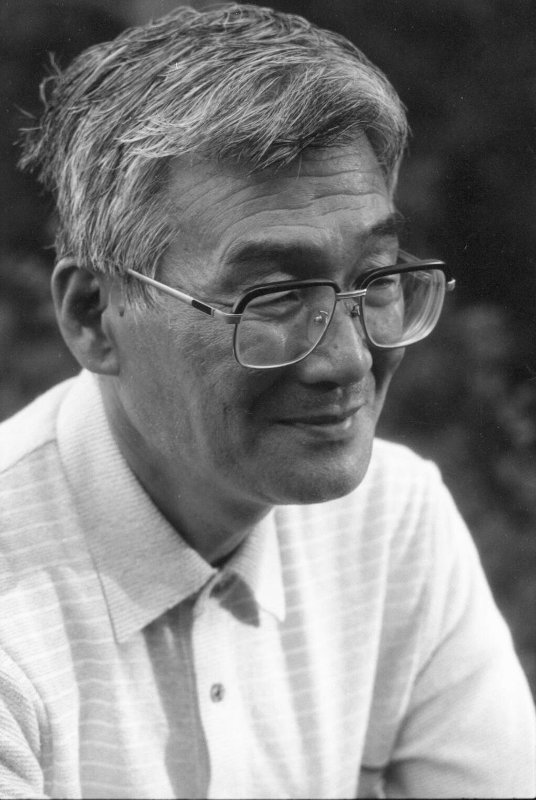
Ikuo Murata (born in 1938) is a linguist and translator that belongs to the first generation of scholars interested in the Baltic languages. In 1963, graduated from Waseda University (studied old and new Indo-European languages). In 1970, he studied Lithuanian and Latvian at the University of Ohio (USA) and the Baltic languages at the University of Stockholm. In Japan, he worked at the Tokyo University of Economics and published numerous articles on the history of morphology in the Baltic languages.
He wrote many review articles on these languages, published dictionaries "1500 Basic Words of the Lithuanian Language" (lit. "Lietuvių kalbos 1500 bazinių žodžių") (1994) and "1500 Important Words of the Latvian Language" (lit. "Latvių kalbos 1500 svarbių žodžių") (1997), together with short grammars. In 1973-1977, translated the part of Kristijonas Donelaitis' "Year" (lit. "Metai") and the part of Antanas Baranauskas' "Anykščiai forest" (lit. "Anykščių šilelis"), works of Lithuanian folk tales, V. Adamkus, J. Mekas, and other Lithuanian authors into Japanese. In 2001, awarded the Order of Gediminas of the Grand Duchy of Lithuania.
(Klaipėda District Library of I. Simonaitytė archive)
Tamio Yanagisawa is a third-generation Baltic linguist. He was a student of Michio Yan, who continued his studies at Nagoya University. He is considered one of the most famous Lithuanian accentology specialists in Japan, and most of his works on this topic were published in the 1990s. In 1990, his "Short Dictionary of Lithuanian-Japanese" (lit. "Trumpas lietuvių-japonų kalbų žodynas") consisting of around 10 thousand words with a short grammar of the Lithuanian language was published.
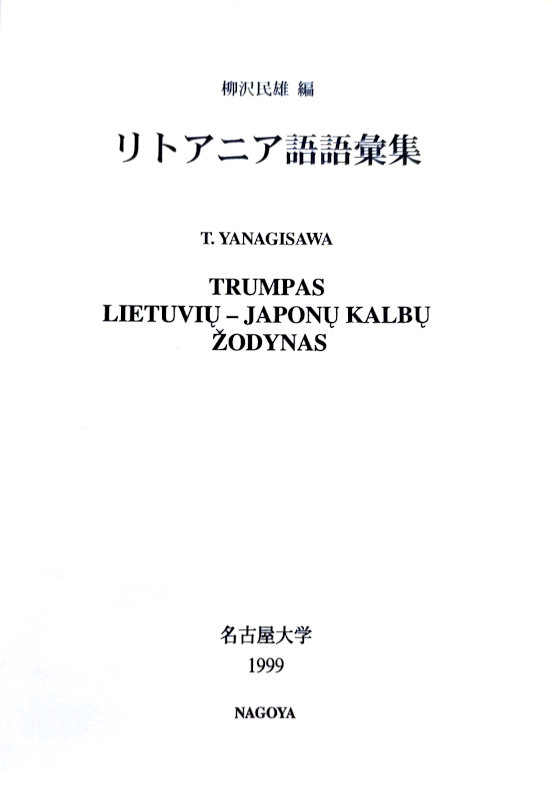
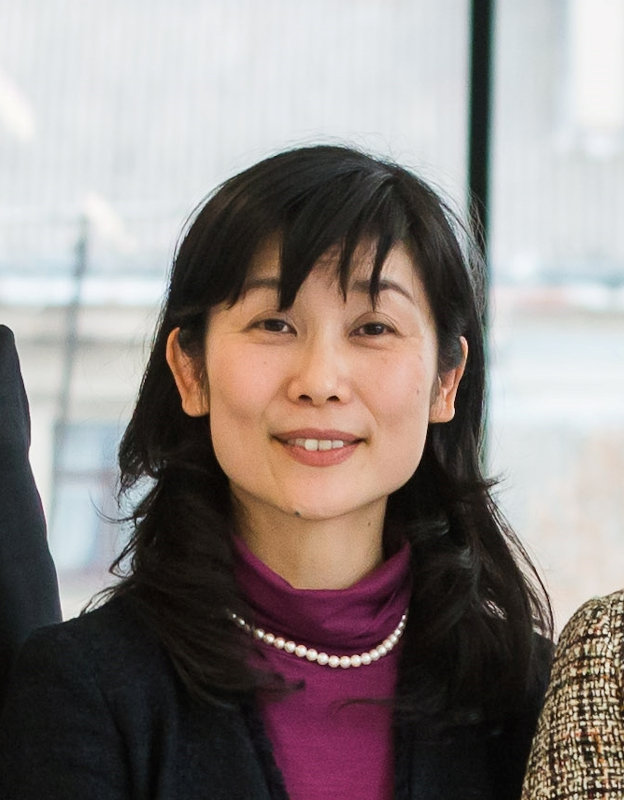
Eiko Sakurai – a third-generation Baltic linguist, a student of prof. Michio Yano, started working at Nagoya University and later at Osaka University of Foreign Studies. She is currently working at the Tokyo University of Foreign Studies, where she is teaching Lithuanian and is researching the morphology and syntax of the Lithuanian language and has already published many articles on the subject. In 2007, she published the first textbook of the Lithuanian language for Japanese learners.
(J. Petronis / VDU)
Aya Kimura, who graduated from Ochanomizu University in Tokyo, is currently the most active translator from Lithuanian and also works as a Lithuanian teacher. Many Lithuanian authors have been introduced to the Japanese readers thanks to A. Kimura‘s translations, such as poet Salomėja Nėris or author of children books Marius Marcinkevičius. One of A. Kimura's e latest translations is a book "Siberian Haiku" (lit. "Sibiro Haiku") which presents the history of Lithuanian exile in a language understood by both children and adults.
(A. Kimura personal archive)
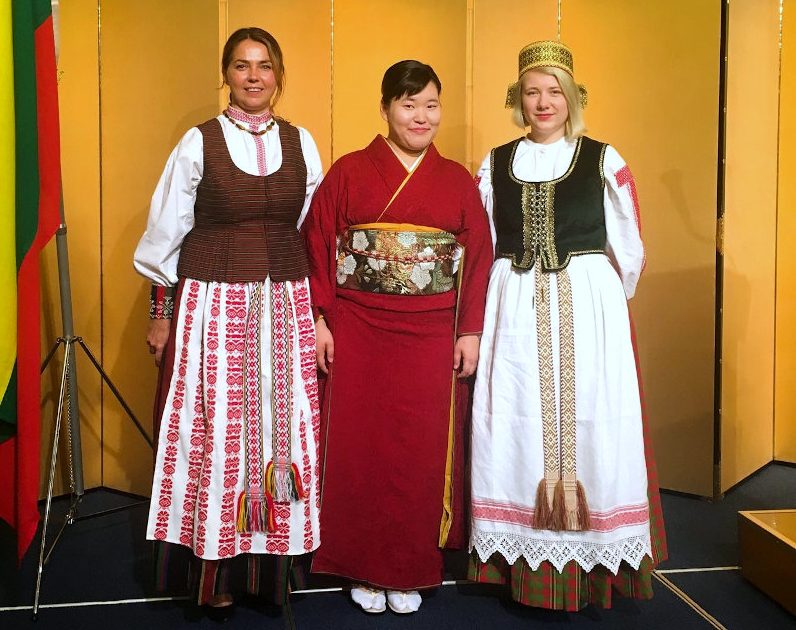
Books about Lithuania in Japanese
The most comprehensive book presenting Lithuania in Japan is "A Collection of 60 Articles on Getting to Know Lithuania" (lit. "60 straipsnių rinkinys Lietuvai pažinti"), which was published in 2020 by Eiko Sakurai. The book presents the Japanese readers with the country’s history, society, culture, economy, politics, and other topics. Since 1972, when the Japanese translation of "Eglė, the Queen of Serpents" (lit. "Eglė Žalčių karalienė") appeared, more than 40 books presenting Lithuania from various perspectives have been published. If the literature on Sugihara's activities in Kaunas would be added, the list would be even longer.
Ikuo Murata, Eiko Sakurai, Aya Kimura, and Hisashi Shigematsu are considered the most prolific Japanese-Lithuanian translators.
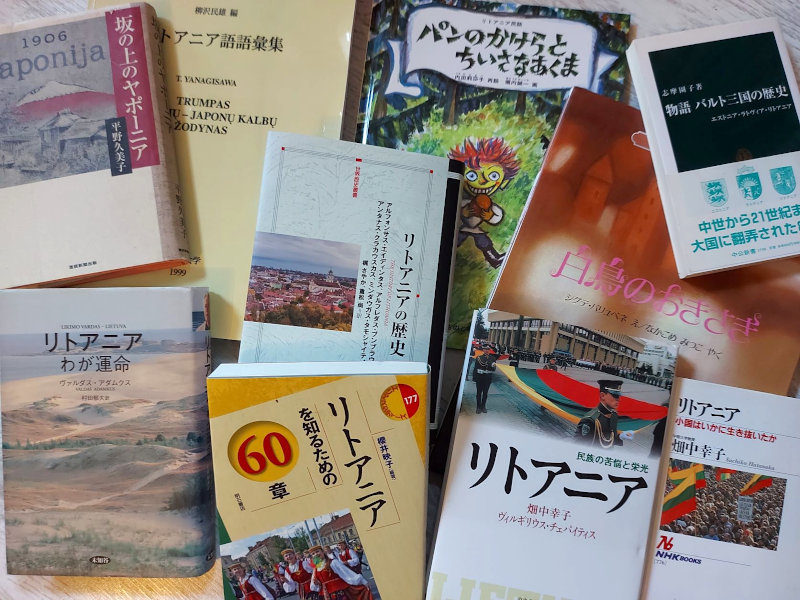
(photo by A. Zykas)
The first acquaintance of the Japanese readers with Lithuanian fiction was initiated through the Ikuo Murata translations of K. Donelaitis and A. Baranauskas. In 1973, the eight volume of the Journal of Humanities and Natural Sciences of the Tokyo College of Economics published an excerpt from K. Donelaitis' "Year" (lit. "Metai") – the first 144 lines of the part depicting springtime. Between 1973 and 1977, I. Murata published parts of "The Year" (the springtime and summertime parts) and an excerpt of "Anykščiai Forest" in the university's journal. The original text was presented together with the Japanese translations. In addition, the history of Lithuania, the works of other authors, and translations into other languages were represented in the journal. However, these translations were never published as separate books, and, therefore, remained known only to the academic community.
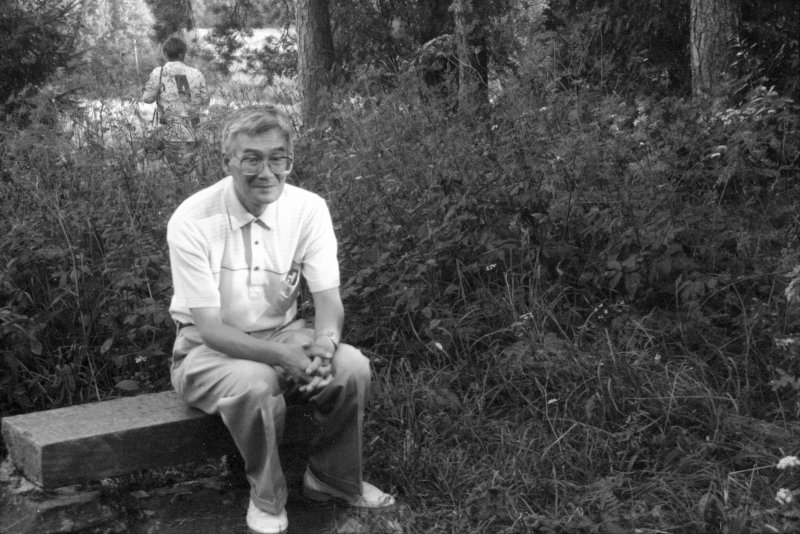
(Klaipėda District Library of I. Simonaitytė archive)

Steponas Kairys was the first Lithuanian to write books about Japan. Sachiko Hatanaka, a professor at Chubu University, was the first Japanese who wrote the first original book about Lithuania. It was published in 1996 under the title “Lithuania. How a Small Country Remained” (lit. “Lietuva. Kaip išliko maža šalis”). The book represents the history of Lithuania, resistance, and the independence movement. In 2006, together with Virgilijus Čepaitis, she published another book on the history of Lithuania.
Lithuanian history, especially of the 20th century, is a topic that raised the interest of Japanese society and was presented through various books. Sonoko Shima, who wrote “The History of the Baltic States“ (lit. “Baltijos šalių istorija“) (2004), and Kumiko Hirano, who wrote about Steponas Kairys (2010), were actively conducting research on this topic. The list of books about Lithuanian history was supplemented by translated books of memoirs by Juozas Urbšis (1991), Valdas Adamkus (2002), the Lithuanian Historical Society's “The History of Lithuania“ (lit. “Lietuvos istorija“) (2013), and Simonas Strelcovas' “Good, Bad, Poor“ (lit. “Geri, blogi, vargdieniai“). In addition, many publications on the feat of Chune Sugihara in Kaunas have been published in Japanese.
Ikuo Murata's "Eglė, the Queen of Serpents" (lit. “Eglė Žalčių karalienė”) published in 1972 was the first known translation of Lithuanian literature into Japanese. Later, various translations from Lithuanian, Russian, and German introduced Japanese children to such fairy tales as "Mildutė", "Swan, wife of the king" (lit. “Gulbė karaliaus pati”), and others. All these translations came to light during the Soviet era and sought to present the folklore of "one of the Soviet Union nations."
In 2019, a wave of translations of Lithuanian books for children began. Within a couple of years, two Kakė Makė (translated by Haruka Seto) books and Marius Marcinkevičius' "Small Poems for Little Ones" (lit. “Maži maži eilėraščiai mažiems”) have been published. They were translated by Aya Kimura, who also translated the work of Salomėja Nėris.
Japanese, who received awards for merits to Lithuania
The fact that 31 Japanese received the Lithuanian state award, the highest number among all Asian countries, is the best reflection of the friendship between Lithuania and Japan. The list includes the journalists who have covered the events of the restoration of independence, scientists who have established academic connections, politicians who have promoted cooperation between municipalities, and others.
(important information for this section was supplied by Audrius Sabūnas)
(G. Varvuolis awarding K. Ochiai, 2020; Lithuanian Embassy in Japan)

January 13th Commemorative Medal
In 1992-1993, many Japanese were awarded the January 13th Commemorative Medal for making a significant contribution to the restoration of Lithuania's independence. Masaru Sato, a diplomat, who worked at the Japanese Embassy in Moscow from 1988 to 1995, was among them. During the events of January 13th, he expressed his support to Lithuania by using the embassy's communication tools and sharing information. He described the events in his book "The Fall of the Empire" (lit. "Imperijos griūtis"): "I spent two days at the embassy, and every hour or two I called the Ministry of Foreign Affairs in Vilnius and the Lithuanian mission in Moscow to report on news from the West and Japan."
Among the recipients of the Commemorative Medal are the correspondents and journalists of several Japanese television stations who highlighted and contributed to the January 13th and other 1989-1991 events, i.e. Yoshio Nakayama, Hiroshige Shinmi, Hiroyuki Fuse, Mikijio Ikuma, Ichiro Taniguchi, Koichi Hamazaki, Kenro Nagoshi, Hiroyasu Yamazaki, Shigeyuki Yoshida, Yoshihiko Matsushima, Takeshi Iwashita, and Kiyoshige Sega.
Diplomats and politicians
- Chiune Sugihara. After his death, on the 27th of October, 1993, awarded the Cross of Salvation. He was a diplomat in Kaunas who issued visas to Jewish refugees from 1939 to 1940.
- Koichiro Matsuura. On the 22nd of April, 2001, awarded the Order of the Lithuanian Grand Duke Gediminas - a diplomat who was the Secretary-General of UNESCO during the award.
- Yoshiaki Kuji. On the 3rd of February, 2003, awarded the Officer Cross of Vytautas the Great. He was the mayor of Kuji, who maintained a partnership with Klaipėda (1979–2003), sent a letter of protest to Gorbachev in support of the events of January 13th, demanding an end to the violence.
- Hirofumi Nakasone. On the 18th of January, 2007, awarded the Officer's Cross of the Order of Merit for Lithuania - politician, long-term member of parliament, leader of the interparliamentary friendship group between Lithuania and Japan.
- Emperor Akihito and Empress Michiko. On the 22nd of May, 2007, awarded the Order of Vytautas the Great with a gold chain - the Imperial Family of Japan, which ruled from 1989 to 2019; visited Lithuania.
- Junnichi Kosuge and Shigeyuki Hiroki. On the 17th of June, 2013, awarded the Commander's Cross of the Order of Merit for Lithuania. They were diplomats, Japanese ambassadors to Afghanistan, who helped Lithuanian and Japanese forces to cooperate in the Ghowr Provincial Reconstruction Mission.
- Hajime Furuta. On the 4th of July, 2019, awarded the Officer Cross of the Order of Merit for Lithuania. He was a politician, Governor of Gifu Prefecture (since 2005), who made a significant contribution to the development of relations with Lithuania.
- Katsuhiro Ochiai. On the 13th of February, 2020, awarded the Knight Cross of the Order of Merit for Lithuania. He was a politician, mayor of Hiratsuka (since 2011), who significantly contributed to the development of relations with Lithuania.
Scientists
- Sachiko Hatanaka. On the 30th of June, 2000, awarded the Knight‘s Cross of the Order of the Lithuanian Grand Duke Gediminas. A professor of Chubu University, author of the book "Lithuania: How a Small Country Remained" (lit. "Lietuva: kaip išliko maža šalis").
- Ikuo Murata. On the 13th of June, 2001, awarded the Order of the Lithuanian Grand Duke Gediminas. A professor, linguist at the Tokyo University of Economics, author of the first translations from Lithuanian into Japanese.
- Atsushi Takeda. On the 13th of June, 2002, awarded the Knight's Cross of the Order of the Lithuanian Grand Duke Gediminas. A researcher and engineer of the Japan Nuclear Energy Agency. He was a member of the Lithuanian Nuclear Safety Advisory Committee and taught Lithuanian students.
- Makoto Asashima. On the 4th of July, 2017, awarded the Officer's Cross of the Order of Merit for Lithuania. A professor at the University of Tokyo, a researcher in developmental biology, a foreign member of the Lithuanian Academy of Sciences, who significantly contributed to the development of scientific relations between Lithuania and Japan.
- Makoto Suematsu. On the 13th of February, 2018, awarded the Officer's Cross of the Order of Merit for Lithuania - Professor of Keio University, Doctor of Medical Sciences, President of the Japan Agency for Medical Research and Development, actively developing cooperation between Japan and Lithuania in the field of health sciences.
- Eiko Sakurai. On the 7th of July, 2021, awarded the Officer's Cross of the Order of Merit for Lithuania. Lecturer at the University of Foreign Studies of Tokyo and Osaka University, Lithuanian author of books on Lithuania and the Lithuanian language.
Artists
- Tamami Honma. On the 10th of January, 2006, awarded the Medal of the Order of the Lithuanian Grand Duke Gediminas. A pianist who has given several concerts in Lithuania and performed works of Lithuanian composers.
- Miki Hamanaka-Paulauskas. On the 5th of February, 2008, awarded the Knight's Cross of the Order of Merit for Lithuania - soloist of the Lithuanian National Opera and Ballet Theater, since 2014 - prima ballerina, living in Lithuania since 1998.
Bibliography
- LR Prezidento kanceliarija. Apdovanotų asmenų duomenų bazė
- Sato, M. (2006). Imperijos griūtis, Shinchosha (佐藤優『自壊する帝国』新潮社、2006)



